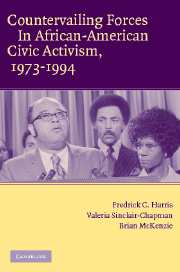Book contents
- Frontmatter
- Contents
- List of Figures and Tables
- Acknowledgments
- 1 Introduction
- 2 Good Times and Bad: Trends in the Economic, Social, and Political Conditions of African Americans in the Post–Civil Rights Era
- 3 Studying Group Activism: Toward a Macro Approach to Black Civic Participation
- 4 Echoes of Black Civic Activism: Historical Foundations and Longitudinal Considerations
- 5 Shifting Forces: Modeling Changes in Post–Civil Rights Black Activism
- 6 From Margin to Center: Bringing Structural Forces into Focus in the Analysis of Black Activism
- Appendix A Question Wording and Coding
- Appendix B Variable Sources and Descriptions
- Appendix C Time Series Models
- References
- Index
Appendix C - Time Series Models
Published online by Cambridge University Press: 15 December 2009
- Frontmatter
- Contents
- List of Figures and Tables
- Acknowledgments
- 1 Introduction
- 2 Good Times and Bad: Trends in the Economic, Social, and Political Conditions of African Americans in the Post–Civil Rights Era
- 3 Studying Group Activism: Toward a Macro Approach to Black Civic Participation
- 4 Echoes of Black Civic Activism: Historical Foundations and Longitudinal Considerations
- 5 Shifting Forces: Modeling Changes in Post–Civil Rights Black Activism
- 6 From Margin to Center: Bringing Structural Forces into Focus in the Analysis of Black Activism
- Appendix A Question Wording and Coding
- Appendix B Variable Sources and Descriptions
- Appendix C Time Series Models
- References
- Index
Summary
Table C.1 presents the findings from three time series models of black civic participation. We use traditional autoregressive moving average (ARMA) models to study movements in black civic participation in the post–civil rights period. Although we use ARMA models instead of intervention models, our ARMA coefficients and statistical tests allow us to determine which set of variables (black empowerment or social and economic distress) are pushing or pulling black civic participation up or down. Like the transfer function weights from a transfer function analysis, our ARMA coefficients provide us with a numerical sense of how much our independent variables influence changes in black civic participation from 1973 to 1994. Our time series tests and model-building procedures follow typical dynamic modeling strategies – descriptive trend analyses, diagnostic checks, and model specification (Cromwell, Labys, and Terraza 1994, 8–10). However, because few scholars use time series models to explain movements in aggregate levels of black civic participation, we will briefly discuss how our substantive arguments can be operationalized using traditional time series analysis techniques.
Before we explicitly modeled movements in aggregate levels of black civic participation over time, we presented a visual plot of each of the black civic participation series in Chapter 3. Next, we investigated whether the participation series were stationary – that is, whether they have a constant mean and variance over time.
- Type
- Chapter
- Information
- Publisher: Cambridge University PressPrint publication year: 2005



